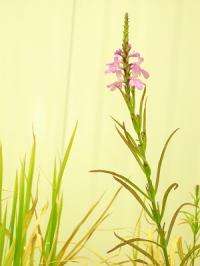Better understanding of triangular hormonal relationship between crop, fungus and parasite

Parasitic plants ruin crops and threaten the food production for some three hundred million people not only in Africa, but also elsewhere in the world. Developing crops are increasingly falling prey to these plants, which literally suck the life out of them. Researchers from Wageningen UR (University & Research centre) have joined forces with colleagues from Switzerland to try to get to the bottom of this problem. In this week’s Nature, they report on the regulating effect of a new protein that may make crops less vulnerable to these parasites.
They are admired in many an African field: Striga plants have spectacular flowers, but they are a scourge to local farmers. These parasitic plants attach themselves to the roots of crops like sorghum, maize and millet where they extract nutrients and water from their hosts, often causing the failure of the entire crop. Previous research showed that the host plants themselves exude substances into the soil via the roots that attract these parasites. But why would a plant help its natural enemy?
The substances concerned, strigolactones, appear to fulfil a second function in the soil. They mobilize beneficial fungae (mycorrhiza), which help the plant to absorb nutrients, especially phosphate. The fungal threads expand the reach of the root system substantially, which is important in poor-quality soil where it is difficult to absorb nutrients. In return, the plant supplies the mycorrhiza with sugars, which are an essential part of the fungae’s diet.
In 2008, researchers discovered a third function of the strigolactones. As a plant hormone, strigolactones suppress the outgrowth of branches in the leaf axils of the plants. Without strigolactones, plants would become bushy with excessive side-shoots. Tomato plants without this regulating hormone grow uncontrollably with dozens of unwanted side-shoots. Their growth ‘steals’ a great many nutrients from the fruit.
Together with colleagues from the universities of Zurich and Fribourg, researchers from the Laboratory of Plant Physiology at Wageningen UR examined what happens in the plant after strigolactones have been produced in the cells. The plant somehow transports the hormone from a plant cell to other cells and into the soil. But how?
The researchers found a specific protein in the plant which appeared to be involved in strigolactone transport. They showed that in plants where this protein was not effective, fewer strigolactones reached the soil, despite there being no change in the level of strigolactone produced in the roots. As expected, these plants were less susceptible to infestation by parasites. Unfortunately, they were also less attractive to mycorrhiza and produced more branching. The researchers think that the discovery of this protein will add to insight into the role of strigolactones in these three different functions.
As the Wageningen researchers are mainly interested in the interaction with the parasite, they are looking for ways of making plants less attractive to parasites without losing the positive effects of mycorrhiza or the repression on branching. A first step may be to curb transportation towards the soil, but not within the plant. This would repress the functions of the strigolactones in the soil without encouraging unwanted branching.
Over the years, work on improving crops has probably unconsciously been based on selecting species with high levels of strigolactones. This is because growers prefer species of sorghum, maize and millet without branching. But it would now seem likely that species without side shoots have high strigolactone levels, a substantial amount of which penetrates the soil and causes more and more aggressive parasite seeds germination. Although strigolactones stimulate the absorption of phosphates via mycorrhiza in poor–quality farming land, this does not always compensate for the damage caused by parasites.
More information: A petunia ABC protein controls strigolactone dependent symbiotic signaling and branching, Tobias Kretzschmar, et al. Nature, March 15, 2012. doi:10.1038/nature10873
Journal information: Nature
Provided by Wageningen University

















